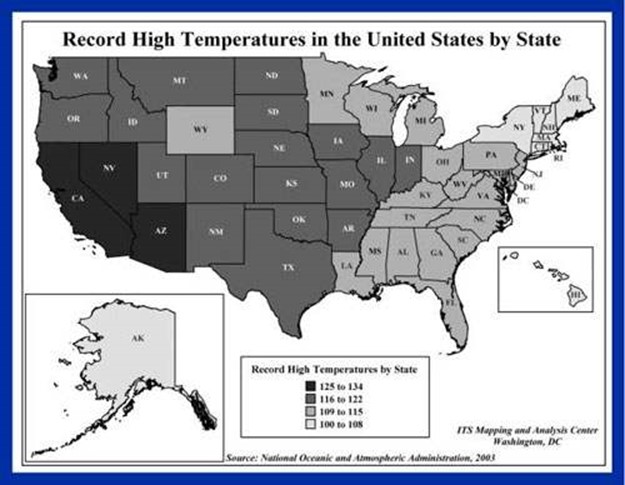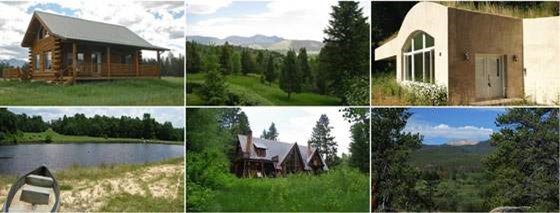Guest post by H.H.
—————–
First, I want to thank all the contributors for all the time and effort that they have put into this blog. I won’t say I have read all of them, but I have considered a significant portion of them not only in my own lifestyle but in my preparation. My own situation is that I work in a large city in the south and the family is miles away. I have been prepping for a few years now and would just like to offer a few observations. I have done all the normal things at the retreat, including food to last years, medical supplies, ammo, and guns– basically the beans, bullets, and band-aid thing. However, I will have this problem one-hundred and sixty five miles door to door! It makes me tired just typing it. If you’re in a large metropolitan area I think you will need more than one escape route. As I started my prepping I became more observant on my travels back to the apartment where I live while at work. What would happen if:
- the Route had no electricity (stop lights weren’t working),
- the Route had electricity (stop lights worked) but I was trapped behind stalled cars,
- the Route had an overpass jammed or an off ramp jammed, or
- I had no transportation because my vehicle is not functioning (get a bicycle)?
Then I started thinking what routes are pointing the way out of town. I thought about roads, railroads, power lines, gas lines, septic systems, and even rain drainage. Okay, so I pulled up Google Earth and started looking around. (Use the “add path” function to highlight, and if you have the snipping tool on Windows it’s great for copying the map.)
- Roads— They’re the normal mode of travel. I planned out at least one route that did not involve off-ramps, overpasses, highways, tollways, etc. Okay, so now I have two routes– my normal route and one involving city internal arteries.
- Railroads—They’re all on Google Earth. Mark the ones you need. In my case I am now up to a total of four routes home and four routes out of town.
- Power Lines—These are also visible on Google Earth. Power companies usually have some type of road for maintenance purposes. However, you might need a bolt cutter to use them!
- Gas Lines—Although they’re not so visible, still keep in mind that those stations sticking up out of the ground do lead somewhere.
- Septic systems and rain drainage. Well, I think you are probably getting the idea.
Anyway don’t get functionally fixed about what is showing you possible routes, just G.O.O.D. (Get Out of Dodge)
What will it be like? First some highlights of an economic breakdown, civil unrest, or nuclear or solar grid-down situation. Just pick your poison. Here’s just a quick review.
- People will want what you have (food).
- People will probably try to take what you have (vehicle gas, water).
- Muggings, gang violence, assorted personal crimes will be rampant (car/bicycle theft).
- You will probably be chased down for anything you may possess. (medical attention required)
- You will consider fleeing the inner city any way possible, but it will be a fight all the way out. (lose weapon, out of ammo)
- You might find a place outside the city (country) that will offer temporary refuge.
- The gangs of people will eventually leave the city for one reason or another.
- Et cetera. I am sure, for the most part, I am preaching to the choir here. Of course, I considered all the normal arteries and methods.
Highways, if available and not clogged with stalled cars, are an option. Just a reminder, if you’re reading this and thinking about using the highways, watch those ramps and overpasses that you might have to use. One stalled car on that ramp or overpass and you’re stuck. These arteries could be jammed with people walking and wondering what happened (if EMP is the event), so this was not my first choice in an EMP event.
Otherwise, the highway will be my first choice if I have an automobile that is operational. Also keep in mind the socio-economic areas (slum) that might be surrounding these highways. (How’s that for being politically correct? Translation, does it go through the ghetto?) I don’t want to get lost in the weeds here too much because those middle class neighborhoods you will go through are more likely to have weapons. This brings us to interior roads.
Residential interior roadways are an option, but here I see the problem being that they are residential. With a grid-down situation, people will not necessarily be in their residence. The bike is a good plan and one I also have as a backup in this scenario. I believe that the probability of more numbers of people being out and about will be higher. So my plan in this scenario involves traveling at late night. The advantages with this scenario are that the availability of water will probably be high (swimming pools), if you have a good activated carbon filter, and the availability of stores.
A few years back, I had experience with electrical overhead distribution. Don’t dismiss this as a viable, although not paved, road. Most of those lines you see overhead need to be maintained and at regular intervals there will be structures to offer shelter. Needing to be maintained means, that they need to be accessible by trucks and other heavy equipment. Also, if you have previously studied the way they are laid out, it can be better than a map about the direction you are headed.
The same general principles apply to gas lines and other public utility structures. They can offer a means of not only direction but also escape. It might be worth your wild to at least become basically familiar with how these roads are laid-out.
Let me offer how I came to a conclusion. I was watching a show that my son likes on TV, and it was a show that had to do with a group of people escaping zombies. I was struck by the similarity between eluding the zombies and eluding “gang-bangers” or any type of rogue band of militia-ish type personnel.
This band of people had trouble organizing the very basics. Just to escape they had to:
- Avoid the zombies and get food.
- Avoid the zombies and get gas.
- Avoid the zombies and get water.
- Avoid the zombies and get transportation.
- Avoid the zombies and take care of the wounded.
- Avoid the zombies and get weapons.
- Avoid the zombies and get ammo.
Is this starting to sound familiar? If by the grace of God you manage to do all of these (and numerous other daily events we take for granted), avoid the zombies, and still “get out of Dodge”, there is some good/bad news: Zombies generally do not have GUNS. In the real world, that will be different.
In addition, if you “waited to evac” the gangs are probably going to have weapons from the National Guard or are going to be the National Guard.
This is from J.W.’s book:
“Provisional Government President Maynard Hutchings”
“At least twenty-eight million are estimated to have been killed in lawless violence.”
My personal belief is that this is very conservative. It will boil down to two people meeting, and one wants what the other has, “one is usually not walking away from this confrontation”. I believe in very short order (probably no more than a few days) the population of urban areas will be cut in one-half. (One didn’t walk away. Multiply this by hundreds of millions of confrontations.)
Some advice to J.H. regarding the question Letter Re: Prospects for the Eastern U.S. in a Societal Collapse. I don’t think I could add any more to your issue than to offer similar advice to the one offered in the letter of Mar. 30 2012 by D.S.A.
“The dichotomy is that people are the biggest threat, but you can’t survive without the cooperation of other people. You can’t make it through the listed events alone; you have to rely on other people to pool all your resources to survive. Every event on that list will cause people to lose their minds and cause chaos. Give it a couple of days, then the looting, crime and civil unrest explode like a powder keg. Sure, you can crawl in your bunker, but for how long? You can buy 20 guns, but you can only shoot one at a time. You need to get organized, with a group of trusted friends/family, to provide, protect and plan your hopefully short term situation. The well-organized, well-armed groups will get passed by the marauders for easy pickings down the road.”
- Plan your escape first! G.O.O.D or urban “AREAS” as the case may be.
- Get a like-minded group together and plan. “Prepare to get mobile”
-
Like the people escaping from the “zombies” follow the list.
- Avoid the marauders and get food.
- Avoid the marauders and get gas.
- Avoid the marauders and get water.
- Avoid the marauders and get transportation.
- Avoid the marauders and take care of the wounded.
- Avoid the marauders and get weapons.
- Avoid the marauders and get ammo.
- Avoid the marauders and get food.
- I applaud you if you have the resources/opportunity to get to the “American Redoubt” but if you don’t, pick a spot to retreat to and that will offer refuge at least temporarily.
Now, I am probably going to say something that will cause a lot of you to cringe. I would not be picky about who owns this retreat, so long as it doesn’t get you shot! The fact is that in these types of situations “ownership becomes a relative term”, whether it is an apple or a parcel of land in the middle of nowhere is not going to mean a thing, hence the reason for weapons.
Now the good news is that I do believe that there are good people out there who are prepared not only for themselves but for the possibility of helping others survive. Also, we realize that there must be “in some fashion” a continuation of the species. I am not advocating that you act like a band of “Rogue-Marines”. This will get you shot, eventually. What I am saying is that you should get to a place that has water, some hunting or fishing, regroup, and move-on “if you must”. This is exactly what happened to our intrepid band of zombie avoiders in the TV show.
(Hugh Interjects: Yes. I cringed when I read this. Even if you are in a life-and-death situation, you should not just “take” what someone else has stored. I understand using enough of the supplies to keep yourself alive, but you should replace them at the first opportunity to do so. You may be “taking” supplies that someone else may be depending upon to live. Further, just because the “rule of law” has broken down in society does not mean that ethics and morals no longer apply. God’s law always applies and He is watching. After all, what makes you different than those who got us into this situation in the first place? Hopefully, it is your sense of morals and the ethics that you follow. As Christians, we have the highest of standards that we should adhere to.)
I agree with J.W. in that the cities (urban areas) will become death traps and that TEOTWAWKI, should propel you to G.O.O.D.
Now, as I sit here writing this in Texas (with relatively mild winters), with my own retreat approximately 165 miles away, I am reminded that when you EVAC in the north, winters will probably kill many. Even a mild one with rains will probably be lethal. In general, I would plan to get somewhere south and stay warm.
Now, generally, I recommend you consider your own survival skills!
- Can you hunt?
- Can you fish?
- Can you track?
- What kind of physical shape are you in?
- Can you make a fire?
- Can you hide a fire?
- Can you construct a basic trap or snare?
- Can you set a makeshift tent?
- Do you have basic medical skills and material?
- Are you prepared to live in the wilderness for months/years?
- Are you prepared to pray?
Well, that’s my experience/opinion. Here is praying you are not made one of the zombies. Maybe you will watch a few zombie shows/movies in a new light.
Best to you and yours, and good luck to us all.
Start now to make sure you are staying prepared.
Via: survivalblog
 Follow
Follow


